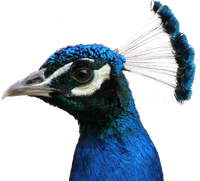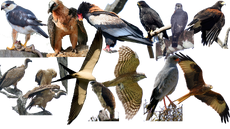| African Fish-Eagle | |
|---|---|
| File:African Fish Eagle.png | |
| An African Fish-Eagle flying. | |
| Scientific classification | |
| Kingdom: | Animalia |
| Phylum: | Chordata |
| Class: | Aves |
| Clade: | Inopinaves |
| Clade: | Afroaves |
| Superorder: | Accipitrimorphae |
| Order: | Accipitriformes |
| Family: | Accipitridae |
| Subfamily: | Buteoninae |
| Tribe: | Milvini |
| Genus: | Icthyophaga |
| Species: | I. vocifer |
| Binomial name | |
| Icthyophaga vocifer Daudin, 1800 | |
| Synonyms | |
|
Haliaeetus vocifer (Daudin, 1800) | |
African Fish-Eagle, Icthyophaga vocifer is a species of eagle in the Buteoninae subfamily and the Milvini tribe. It is closely related to the Madagascan Fish-Eagle (I. vociferoides), White-bellied Sea-Eagle (I. leucogaster) and Sanford's Sea-Eagle (I. sanfordi).[2] It is found in Africa, south of the Sahara.
Icthyophaga is derived from Greek, ιχθυοφαγος ikhthuophagos fish-eating < ιχθυς ikhthus, ιχθυος ikhthuos fish; -φαγος -phagos -eating < φαγειν phagein to eat;[3] vocifer is derived from Latin vociferari to cry aloud < vox, vocis voice, cry, sound; -fera carrying < ferre to bear.[4]
| Click for other names | |
|---|---|
| Other common names | African Fish Eagle, African Fish-Eagle, African sea eagle, African Sea-Eagle, Fish Eagle, River Eagle, West African River-eagle |
Description[]
Length is 63–75 cm (25–30 in); males weigh 1,985–2,500 g (4.376–5.512 lb), females weigh 3,200–3,600 g (110–130 oz); the wingspan is 175–210 cm (5.74–6.89 ft).[5]
Similar species[]
Behaviour[]
Perches for 85–95% of day in productive tropical habitat.[2] Most often seen singly or in pairs on high branches along water.[6] Usually solitary, but more than 100 may gather at concentrations of stranded fish.[2] Hunts mainly from a perch by swooping down to pluck prey from near the water surface, rowing larger prey to shore. Rarely hunts when soaring, but regularly pursues and pirates other piscivorous birds.[2]
Diet[]

Flamingo attacked by fish eagle! - Massive Nature - BBC
An African Fish-Eagle preying upon Lesser Flamingos.

African Fish Eagle Steals a Saddle-Billed Stork's Well Earned Meal
An African Fish-Eagle stealing the prey of a Saddle-billed Stork.
It is a specialised fish eater; more often seen watching from a perch than hunting in flight, it swoops to snatch fish just under the surface, using a backward swing of its feet.[6]
It eats fish![]() that are 200–1,000 g (0.44–2.20 lb), but also up to 4,200 g (9.3 lb).[2] It pursues and pirates other piscivorous birds.[2]
that are 200–1,000 g (0.44–2.20 lb), but also up to 4,200 g (9.3 lb).[2] It pursues and pirates other piscivorous birds.[2]
It also feeds upon carrion, waterbirds (including colonial species), mammals (monkeys and hyraxes), reptiles (monitor lizards, terrapins and crocodile hatchlings), frogs and even insects; whatever is locally available.[2] Immature birds feed on the kills of Lions and Leopards in Uganda.[7] At Lake Naivasha in Kenya, Red-knobbed Coots and fish were important prey.[8]
Calls[]
During its display call, it throws its head backwards and forwards.[9] The call is a distinctive, far-ranging “WEEE-AH kleeuw kleeuw kleew” given by both sexes;[10] the loud yelping calls are uttered when perched or in flight, often as a pair in duet, synonymous with the African waterways.[2]
Reproduction[]
They lay eggs in any month in most regions, but locally seasonal and generally favours low water conditions, with peak in Oct–Dec/Jan in W Africa; Jul–Oct in Uganda; Jun–Aug in S Africa.[2]
It builds large stick nest in high fork of tree as close to the water as possible, rarely on a cliff or a steep slope. Their nests are 120–150 centimetres (47–59 in) across and 20–60 centimetres (7.9–23.6 in) deep when first built.[5] Usually lays two eggs (or one-four); incubation is 42-45 days.[2]
Chicks have white down; fledging is 65–75 days; occasionally three young fledge,[11] but often only one-two chicks survive to independence, they fledge in about two months after hatching.[2]
Distribution/habitat[]
References[]
- ^ IUCN Red List 2013.
- ^ a b c d e f g h i j k Kemp, A.C. & Marks, J.S. (2014). African Fish-eagle (Haliaeetus vocifer). In: del Hoyo, J., Elliott, A., Sargatal, J., Christie, D.A. & de Juana, E. (eds.) (2014). Handbook of the Birds of the World Alive. Lynx Edicions, Barcelona. (retrieved from http://www.hbw.com/node/52983 on 17 November 2015)."
- ^ Jobling, J. (2015). In: del Hoyo, J., Elliott, A., Sargatal, J., Christie, D.A. & de Juana, E. (eds.), eds. "Ichthyophaga". Handbook of the Birds of the World Alive. Lynx Edicions, Barcelona. Retrieved 11-28-15. Check date values in:
|access-date=(help) - ^ Jobling, J. (2015). In: del Hoyo, J., Elliott, A., Sargatal, J., Christie, D.A. & de Juana, E. (eds.), eds. "vocifer". Handbook of the Birds of the World Alive. Lynx Edicions, Barcelona. Retrieved 11-28-15. Check date values in:
|access-date=(help) - ^ a b Ferguson-Lees, James; Christie, D.A. (2006). Raptors of the World (Princeton Field Guides). Princeton Field Guides. ISBN 0713669578. Cite error: Invalid
<ref>tag; name "RaptorsOTW" defined multiple times with different content - ^ a b Harrison, Colin and Greensmith, Alan (1993). Birds of the World. Dorling Kindersley Inc. ISBN 1564582965.
- ^ Krüeger, O. (1997) Population density and intra- and interspecific competition of the African Fish Eagle Haliaeetus vocifer in Kyambura Game Reserve, southwest Uganda. Ibis 139(1): 19-24.
- ^ Harper, D.M., Harper, M.M., Virani, M.A., Smart, A., Childress, R.B., Adatia, R., Henderson, I. & Chege, B. (2002) Population fluctuations and their causes in the African Fish Eagle (Haliaeetus vocifer (Daudin)) at Lake Naivasha, Kenya. Hydrobiologia 488: 171-180.
- ^ Dr Perrins, Christopher; Dr Harrison, C.J.O. and Cameron, Ad (illu.) (1979). Birds: Their Life, Their Ways, Their World. Readers Digest Assn. ISBN 0895770652.
- ^ Borrow, N. & Demey, R. (2011) Birds of Senegal and The Gambia. Christopher Helm, London.
- ^ Mundy, P.J. & Couto, J.T. (2000) High productivity by Fish Eagles on a polluted dam near Harare. Ostrich 71(1–2): 11-14.
External links[]
| Projects | ||||||
|---|---|---|---|---|---|---|
| ||||||



